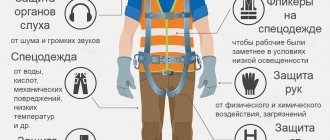Personal protective equipment for workers
Personal protective equipment at work (PPE) is special clothing and special equipment that employees use to reduce exposure, prevent exposure to and protect against harmful and hazardous production factors, including pollution.
PPE is used for safe work performance, especially in cases where sufficient protection cannot be provided in the proper form. Suppose the workplace design has cramped conditions and there is a chance of getting hurt due to careless lifting of the head.
Either the location of the work is such that it is basically impossible to work without personal protective equipment (respiratory protection), or the work is carried out in conditions of poor visibility and it is necessary to indicate the presence of people in the work area.
Protective equipment is divided into two types: individual use and collective use.
To confirm my words, you can study GOST 12.4.011-89 “SSBT. Protective equipment for workers. General requirements and classification."
Classification of personal protective equipment
Personal protective equipment for workers is intended for personal use only and is not transferable to colleagues and is divided into 12 classes.
Classification of personal protective equipment:
- insulating suits (pneumatic suits, spacesuits, etc.);
- respiratory protection equipment (gas masks, RPE, self-rescuers, etc.)
- special protective clothing (sheep coats, coats, short coats, capes, robes, etc.);
- foot protection equipment (boots, boots, shoes, shoe covers, slippers, etc.);
- hand protection equipment (mittens, gloves, shoulder pads, oversleeves, etc.);
- head protection equipment (helmets, helmets, caps, berets, etc.);
- eye protection (safety glasses, etc.);
- facial protection equipment (face shields, etc.);
- hearing protection equipment (ear protectors, ear buds, helmets, etc.);
- fall protection equipment and other safety equipment (safety harnesses, slings with and without shock absorbers, anchor lines, blocking devices, etc.);
- dermatological protective products (creams, ointments, soaps, etc.);
- combined means (a combination of several means of protection in one).
The employer must provide maximum protection to its employees in order to prevent the development of occupational diseases and accidents at work.
Lack of PPE when working at heights
The most common cause of injury in workplaces is falls from height.
The leader is, of course, the construction industry. Rules for working at height, taking into account modern construction and production technologies, came into force on March 28, 2014 on the basis of Order of the Ministry of Labor of Russia No. 155n and were supposed to radically change the attitude towards work at height. The rules changed the criteria for determining work at height, excluding “student work,” and tightened the requirements for organizing training and equipping workers with personal protective equipment.
Instead of a safety belt, to ensure safety when working at height, it is now necessary to use four systems: restraint, positioning, fall arrest system and rescue and evacuation system. These personal protective equipment provide workers with the most complete protection when working at height. PPE used when working at height must be certified, which further increases safety when working at height. It would seem that organizational and individual causes of injury have been eliminated as much as possible. However, statistics show the opposite.
On December 27 last year, a welder from Stroyinovation LLC in the city of Vyksa, Nizhny Novgorod region, fell from a height in the electric pipe welding shop. As a result of the fall, he suffered severe fractures of the pelvic bones. The investigation established that the welder did not have protective equipment when working at height, and there was no fencing at the work site openings. The company was fined 60 thousand rubles, and the site foreman who committed violations was fined 5 thousand rubles. The investigation materials were transferred to the prosecutor's office, which will decide whether there are grounds for a criminal case.
On January 20, 2019, two employees of Balkum LLC, walking through the territory of the enterprise, saw an electric cable hanging from a floodlight mast over the highway. Considering that this would create a danger for vehicles (the threat of cable breakage), we decided to tighten it. In violation of the Labor Safety Rules when working at height, without using personal protective equipment against falls from height, workers climbed a metal floodlight mast, the platform collapsed and one of the workers fell, receiving a complicated spinal fracture and a traumatic brain injury.
The State Labor Inspectorate imposed a fine of 100 thousand rubles .
A blatant case of neglect of the rules when working at height by the work manager - a foreman of construction and installation works - was identified by the State Labor Inspectorate of Khabarovsk.
The construction organization "Favorit" LLC undertook to ensure the completion of cleaning work on the territory of the high school and the team of this organization began work. The work manager instructed the workers to climb onto the roof of the school building and secure the previously raised stack of metal tile sheets there. The workers put on helmets and safety belts and climbed onto the roof. After some time, the work manager also climbed onto the roof, but without a helmet and safety belt, stood on the ridge of the roof, and subsequently fell down. The arriving ambulance team provided the victim with first aid, then took him to a medical facility, where he died. The head of Favorit LLC was brought to administrative responsibility. The work manager, who is obliged, in accordance with his job responsibilities, to monitor the correct use of issued PPE by subordinate personnel, and not to allow workers without PPE to work, sets an unprecedented example of carelessness towards his own life.
Full range of labor protection, civil defense and emergency services
Enter your phone number and I will calculate an estimate for your tasks. Enter without the eight. “Bureau of Ekaterina Vorontsova” – professional solutions to your problems: with high quality and on time!
The right savings on PPE
From personal experience, I’ll tell you what to look for when choosing any personal protective equipment, because the catalogs of specialized stores are full of different suits, shoes, and other things, and managers are trying to “sell” their product.
So, initially, before switching from one supplier to another, or you initially choose a counterparty, ask for several samples of suits, safety shoes and other things for testing.
The supplier of personal protective equipment must provide this product free of charge, with subsequent preparation of a test report by you.
You give the received PPE to your employees for use. Usually a week is enough, sometimes a little less, to understand how comfortable it is for employees to work and whether the quality really corresponds to what the manufacturer declared, and whether it will become unusable before the end of the wearing period, for example.
Therefore, the company’s budget in terms of purchasing personal protective equipment is often meager, so it is better to immediately buy the right one.
At many enterprises, there is an overexpenditure of workwear, safety footwear and personal protective equipment during the calendar year due to the purchase of low-quality goods.
For example, as was the case in my practice.
The workers were given suits (I will not mention their name or company) with a fabric density of 215 g/m2. During active use, the wear period was actually 4-6 months, instead of the 12 months of operation required by the standards.
During work, burnouts and multiple tears very quickly appeared on the workwear, which indicated a discrepancy between the quality of the material and the work performed at the enterprise. I'm not saying that the costumes are bad - no! They were simply not suitable for the nature of our business.
Therefore, after analyzing, a proposal was made to the supply department to purchase suits with a higher density (over 245 g/m2) and with a high cotton content (over 50%), which was supposed to contribute to a longer wear period and eliminate unnecessary financial costs.
And so it happened! For the majority of workers, by the end of their wearing period, their workwear was worn out by a maximum of 70-80%. Moreover, the cost of the suits was almost the same, thereby saving the company more than one million rubles.
You can do the same with safety shoes and other personal protective equipment - analyze and test before purchasing large volumes. And then we will analyze what collective means of protection are and what classes they are divided into.
Collective protection equipment for workers
Collective protective equipment at work (CPS) is a device and structure that allows you to protect a large number of workers from exposure to harmful and dangerous production factors, harmful substances, and contaminants.
That is, unlike PPE, it affects all production employees immediately en masse, and not personally, depending on whether the employee has “rubber boots” or not.
List of collective protective equipment at work
- Devices for normalizing the air environment of industrial premises and workplaces. These are devices that maintain optimal barometric pressure, sufficient air purification, air conditioning and ventilation in the work area, heating and air deodorization.
- Devices for normalizing lighting of industrial premises and workplaces. These devices include light sources, lighting fixtures, light openings, light-protective devices and light filters that provide illumination in the workplace at a level that complies with the standards.
- Means of protection against increased levels of ionizing radiation. To safely carry out work near ionizing radiation, protective, warning, sealing devices, protective coatings, devices for trapping and purifying air and liquids, decontamination devices, automatic control devices, and remote control devices are used. Also, protective equipment is required during transportation and temporary storage of radioactive substances, and, of course, safety signs and containers for radioactive waste.
- Devices for protection against increased levels of infrared radiation. To protect employees from infrared radiation above the standard level, it is necessary to use protective, sealing, heat-insulating devices, automatic control devices, alarms, remote control, as well as ensure sufficient ventilation and safety signs.
- Protection from low or high levels of ultraviolet radiation. Security will be helped by fencing, sealing, heat insulating, ventilation, automatic control and alarm devices, remote control and safety signs.
- Devices against increased levels of electromagnetic radiation. They are fencing, ventilation, automatic control and alarm devices, remote control and safety signs.
- Devices against increased intensity of magnetic and electric fields. They include fencing and sealing devices, protective coatings, automatic control and alarm devices, remote control and, of course, safety signs.
- Devices against increased levels of laser radiation. As with all of the above dangerous radiation, to protect workers from harmful factors, it is necessary to use protective, sound-insulating, sound-absorbing devices, noise mufflers, automatic control and alarm devices, and remote control.
- Remedies for increased noise levels. To reduce the impact of harmful and dangerous factors, it is mandatory to use protective devices, soundproofing, sound-absorbing devices, noise mufflers, automatic control and alarm devices, and remote control.
- Means of protection against increased levels of vibration (general and local). To reduce the impact of vibration on the human body, protective devices, vibration-isolating, vibration-damping and vibration-absorbing devices, automatic control and alarm devices, and remote control are used.
- Protection devices against increased levels of ultrasound. These devices include fencing, soundproofing, and sound-absorbing devices, as well as automatic control, alarm and remote control devices.
- Remedies for increased levels of infrasonic vibrations. If the level of infrasonic vibrations is high, fencing devices and safety signs are used.
- Electric shock protection devices. These are fencing devices, automatic control and alarm systems, insulating devices and coatings, protective grounding and grounding devices, automatic shutdown devices, etc.
- Protection devices against increased levels of static electricity. Includes grounding and humidifying devices, neutralizers, anti-electrostatic agents and shielding devices.
- Means of protection against high or low temperatures of equipment surfaces, materials, workpieces. These are devices: fencing, automatic control and alarm, thermal insulating, remote control.
- Means of protection against high or low air temperatures and temperature changes. These are fencing devices, automatic control and alarm, thermal insulation, remote control, for heating and cooling.
- Means of protection against mechanical factors. They include devices: protective, braking, automatic control and alarm, safety and remote control, and, of course, safety signs.
- Means of protection against exposure to chemical factors. These are protective means for protecting workers, automatic monitoring and alarms, sealing, providing the necessary ventilation and air purification, as well as the removal of toxic substances, remote control and safety signs.
- Devices for protection against biological factors. These are equipment and preparations for disinfection, disinfestation, sterilization, deratization, fencing devices, ventilation and air purification and safety signs.
- Devices for protection against falls from height. These include barriers, safety nets and safety signs.
Hmm, there are a huge number of protective equipment, the main thing is not to forget to use them.
Personal and collective protective equipment - is it possible to save money?
Labor safety rules were written in blood and all these means of individual and collective protection were invented for a reason, but in order to protect people at work, and employers, of course.
Based on the experience of Western specialists who keep statistics on industrial hygiene and occupational diseases, it was concluded that simply using PPE to protect against harmful and industrial exposures is not reliable enough.
They certainly need to be used, but they must be used in conjunction with more reliable methods of protection. For example, this is the automation of hazardous industries, the introduction of effective ventilation methods, alarm and remote control devices.
That is, only the joint use of personal and collective protective equipment will help the employer avoid future occupational diseases of employees, injuries or accidents.
The law also provides incentives for employers who do not want to adequately improve working conditions and use effective PPE.
Federal Law No. 426 makes it possible to reduce the classes of harmful production factors in workplaces based on the results of special environmental protection measures, through the use of collective protective equipment, which will also bring savings in the form of reduced payments to both employees and the Pension Fund of the Russian Federation.
In addition, the employer has the right to receive compensation from the Social Insurance Fund for the purchase of personal protective equipment. Based on the above, it is possible and necessary to save, but do it with your head and not to the detriment of people - life is still the main thing!
Main conclusions
I understand that sometimes there is no money even for a helmet, let alone special clothing and other personal protective equipment. But the management of the enterprise should be interested in providing PPE to workers, because this reduces injuries. Plus, if an unscheduled inspection of the State Labor Inspectorate is ordered in connection with an accident, management will be forced to pay colossal fines for their own violations and nevertheless provide workers with special clothing. As they say: “The miser pays twice!”
The use of personal and collective protective equipment for workers helps to minimize the impact of harmful and dangerous factors on the body of employees, even in hazardous production, you just need to strive for this.
I wish you efficient and safe work.
If you have any questions, write in the comments - we will sort it out. If necessary, we will prepare a package of documents for you, please contact us.
What are the means of protection?
According to Art. 209 of the Labor Code of the Russian Federation, means of individual and collective protection of workers - technical means used to prevent or reduce the impact of harmful or hazardous production factors on workers, as well as to protect against pollution. Personal protective equipment, including foreign production, must be certified in accordance with the procedure established by Decree of the State Standard of Russia dated June 19, 2000 N 34 “Rules for the certification of personal protective equipment.” The acquisition and issuance of personal protective equipment to employees that does not have a certificate of conformity is not permitted.
PPE refers to personal equipment used to prevent or reduce exposure of workers to harmful and (or) hazardous production factors, as well as to protect against pollution. (Clause 3 of Chapter 1 of the Intersectoral Rules)








